Pokédex entry
A Pokédex entry (Japanese: 図鑑説明文 illustrated encyclopedia explanatory note) typically describe a Pokémon in only two or three sentences. They may give background information on the habitat or activities of a Pokémon in the wild or other information on the Pokémon's history or anatomy. Pokédex entries also include height, weight, cry, footprint (prior to Generation VI), location, other forms, and a picture of the Pokémon.
In the core series games
The main feature of the Pokédex are the entries on each individual Pokémon, which provide details that would otherwise be unexplored in the games. If a Pokémon is caught, its full Pokédex entry becomes available. A Pokémon that was seen but not caught has a partial entry.
From Generation VII onwards, some Pokémon forms have separate Pokédex entries, each form with its own text description, type, category, height, and weight. In some cases, this includes separate entries for regional forms, Mega Evolutions, Gigantamax forms, Pikachu in a cap, and so on.
The table below contains the information available in the Pokédex.
| Game | RBY | GSC | RSE | FRLG | DPPt | HGSS | BW | B2W2 | XY | ORAS | SM | USUM | PE | SwSh | BDSP | LA | SV |
|---|---|---|---|---|---|---|---|---|---|---|---|---|---|---|---|---|---|
| (available for a seen Pokémon) Pokédex number Image (sprite or render) Category Cry Area map |
✔ | ||||||||||||||||
| Species name Description Height value Weight value |
✔ | ||||||||||||||||
| Footprint | ✘ | ✔ | ✘ | ✔ | ✘ | ||||||||||||
| Type | ✘ | ✔ | |||||||||||||||
| Height comparison | ✘ | ✔ | ✘ | ||||||||||||||
| (available for a seen Pokémon) Cry's visible soundwaves |
✘ | ✔ | ✘ | ✔ | ✘ | ✔ | |||||||||||
| (available for a seen Pokémon) List of forms Gender differences |
✘ | ✔ | |||||||||||||||
| Foreign entries | ✘ | ✔ | |||||||||||||||
| Weight comparison | ✘ | ✔ | ✘ | ||||||||||||||
| Forms with separate entries | ✘ | ✔ | |||||||||||||||
| Number of caught Pokémon of each species Height records (tallest and shortest caught) Weight records (heaviest and lightest caught) Genders caught |
✘ | ✔ | ✘ | ||||||||||||||
| Research level | ✘ | ✔ | ✘ | ||||||||||||||
Although the Pokédex has is able to search Pokémon by color in Generations III–VII, it has no feature to indicate what is the color of a specific Pokémon.
In Pokémon Legends: Arceus, unlike most Pokédexes, the Pokémon’s entry is not immediately added upon one being captured. Instead, it is only added by completing enough research tasks. Additionally, many of the entries are written in first person by Professor Laventon. The cover of the book starts out appearing brand new at the beginning of the game, but slowly becomes more worn as the game progresses.
Description
A short text description is available for each Pokémon in the Pokédex.
In Generation I, the Pokédex text entry is split into two pages; the player can press A to go to the next page. In Generation II, the Japanese games do not have multi-page Pokédex entries; international versions have a "Page" button for long Pokédex entries. In Pokémon Ruby and Sapphire, there is a Page button to switch between pages of multi-page Pokédex entries.
From Pokémon FireRed and LeafGreen onwards, the description is displayed on a single page for each Pokémon.
From Pokémon Sun and Moon onwards, but excluding Pokémon Brilliant Diamond and Shining Pearl, some Pokémon with alternate forms have separate Pokédex entries for their different forms, provided that those alternate forms are available in the game's regional Pokédex. This includes, but is not limited to, regional forms, Mega Evolutions in Generation VII, and Gigantamax forms in Pokémon Sword and Shield. In Pokémon Scarlet and Violet regional forms from other regions are excluded.
Entry recycling
- Main article: Pokédex entry recycling
Several Pokédex entry descriptions have been introduced in certain games and then reused in later games, with some games having a mix of original entries and recycled entries. There are also several pairs of games that either have different entries for each Pokémon or reuse some entries between both games.
Foreign entries
- Main article: Foreign Pokédex entry
From Generation IV onwards, it is possible to register Pokédex entries in foreign languages.
In Pokémon Diamond and Pearl, foreign Pokédex entries are available for 14 Pokémon species after the player meets Meister. In Pokémon Platinum, this function was expanded to all Pokémon, although it still requires Meister to update the Pokédex. From Pokémon HeartGold and SoulSilver onwards, foreign entries are available for all Pokémon from the start of the game.
Forms
From Generation IV onwards, the Forms page allows the player to see a list of forms and gender differences, as long as the player has seen them before. In Pokémon HeartGold and SoulSilver, Forms added a Compare option to see different forms side by side instead of having to scroll between them.
From Generation IV to Generation VI, males and females of all Pokémon with differing gender are shown separately under in the Forms section even if there is no visible gender difference.
In Generation V, the Forms page is added by Cedric Juniper when the player visits Mistralton City.
From Generation V onwards, the Forms page displays Shiny Pokémon as well, and the last sprite selected will become the one displayed in the main entry.
From Generation VII onwards, a Pokémon's gender is only shown separately under the Forms section if there is a visible gender difference. Starting this generation, several Pokémon have separate Pokédex entries for different forms, including event-exclusive forms, regional forms and Mega Evolutions. Each form's entry has its own text blurb, and may also have a different category, type, height, weight, color, and shape. Once a Pokémon with form differences is caught, Pokédex entries are unlocked for all forms that has been seen, even if the player has never owned a Pokémon in this form yet.
In Generation IX, however, the Pokédex doesn't have a Forms page, and players can view the forms of the Pokémon they caught last. In these games, different regional forms have separate entries in different Pokédexes, and capturing one form of Pokémon only adds the entry to a Pokédex in which it is listed (for instance, capturing a Paldean Wooper adds an entry to the Paldean Pokédex, but does not mark Johtonian Wooper in the Kitakami Pokédex as caught).
Cry
In Generation I, the Pokédex list has an option to play the Pokémon's cry (without opening a new screen). From Generation II onwards, the Pokémon's cry is available once the player enters the Pokémon entry.
In most games from Generation III onwards, the Pokémon's cry option (available from the Pokémon entry page) now brings the player to a separate page, which displays the sound wave as it is played. However, there is no Cry page in Pokémon FireRed, LeafGreen, HeartGold, or SoulSilver.
In Pokémon Diamond, Pearl, and Platinum, Cry has a bar display in addition to the wave display, and the ability to modify the cry via Chorus/Pan, Reverb/Filter and Loop.
In Pokémon Brilliant Diamond and Shining Pearl, the player can change the filters put on cries by using the gyro sensors on their controllers, as opposed to a touch screen.
Area
In Generation I, the "Area" option displays the map, along with flashing indicators at each location where the selected Pokémon can be found; in cases where the Pokémon is not available in the wild, is only available once, or can only be found by fishing or in Cerulean Cave, the message Area Unknown (Japanese: せいそくち ふめい Habitat Unknown) will be displayed over the center of the map instead.
In Generation II, the new Pokédex instead displays an unmarked map in place of the aforementioned message. Furthermore, it is possible to switch between Johto and Kanto using the ← or → buttons when the current map is Kanto or Johto, respectively. The flashing indicators can also be omitted and replaced with the player's current position by pressing the SELECT button.
In Generation III, the Area section was changed to highlight locations instead of just marking them and can now display the locations of Pokémon obtainable by fishing.
In Pokémon Diamond, Pearl, and Platinum, Area now changes its highlight color depending on whether a Pokémon is found normally or exclusively using Honey, and the player can view the differences between morning, day and night, with the default being the current time.
In Pokémon HeartGold and SoulSilver, Area no longer defaults to the current time or differentiated for Honey due to it no longer being a mechanic.
In Pokémon Black, White, Black 2, and White 2, instead of showing the time of day that a Pokémon can be caught, the Pokédex shows the seasons in which it can be found. Areas in which the Pokémon can be found flash red, and touching an area will show the methods by which it can be caught (walking in tall grass, surfing, or fishing).
Origin
In Pokémon X and Y, if the player obtains a Pokémon originating from these games, the symbol in the Pokédex indicating it has been caught is a combination of the three Kalos Pokédex symbols: a pentagon with vertical blue, white, and red stripes. This resembles the flag of France, the region on which Kalos is based. If a Pokémon is transferred from another game, the symbol will instead be a Poké Ball. The latter symbol can be updated to the former symbol if the player obtains a Pokémon of that species originating from Generation VI. If all Pokémon are obtained from Generation VI games, the Pokédex will be marked with a crown on the selection screen.
Footprint
From Generation II to Generation V, and in Pokémon Brilliant Diamond and Shining Pearl, a Pokémon's entry displays its footprint.
In Brilliant Diamond and Shining Pearl, pressing the + button on a Pokémon's entry will change their footprint from a single footprint to all footprints if available, showing whether a Pokémon is bipedal or quadrupedal.
Height and weight
The Pokémon's height and weight is displayed in all generations.
In Generation III, a Size section was added, which displays silhouettes of the Pokémon and the player character side by side.
In Generation IV, weight was added to the Size section, which puts the Pokémon and the player character on either side of a balance scale. In Pokémon HeartGold and SoulSilver, Size now uses both screens to display both Height and Weight at the same time
Map and recommendations
In Pokémon Sun, Moon, Ultra Sun, and Ultra Moon, in addition to a standard Pokédex function, the Rotom Pokédex includes a detailed map that can point out nearby locations of interest, and remind the player of the next objective based on recent conversations with NPCs.
In Pokémon Sword and Shield, once per day, the Pokédex will give the player a recommended place to look for Pokémon to complete their Pokédex; these recommendations globally increase the encounter rates of the recommended species, excluding wanderer and curry encounters.[1] When in an area where the recommended species can be encountered, the bonus has 50% chance to activate and attempt to spawn a recommended species, with a 25% chance for each of the 4 recommended species slots being selected. This fails if it lands on a blank recommendation slot, or a species that doesn't spawn in the current encounter pool, in which case it defaults to the normal encounter pool.[2] This bonus only affects the first form of a recommended species, determined by the index number of the form.[3] As an example, Sinistea being recommended in the Old Cemetery would also boost the encounter rate of Sinistea in Glimwood Tangle, but only for Phony Form Sinistea, not Antique Form.
Gallery
Game Boy and Game Boy Color

|
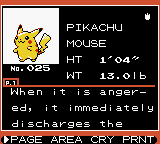
|
|---|---|
| RBY | GSC |
Game Boy Advance
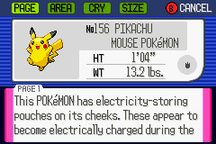
|
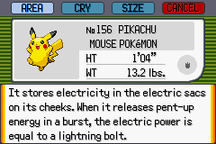
|
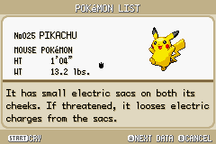
|
|---|---|---|
| RS | E | FRLG |
Nintendo DS
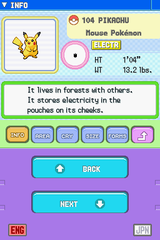
|

|

|
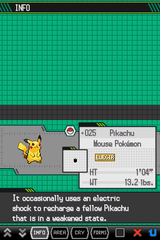
|
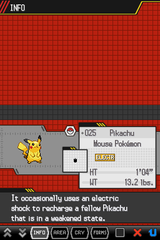
|
|---|---|---|---|---|
| DP | Pt | HGSS | BW | B2W2 |
Nintendo 3DS
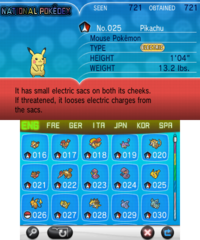
|

|
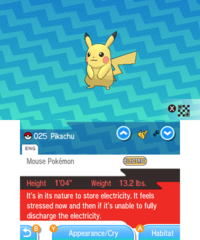
|
|---|---|---|
| XY | ORAS | SMUSUM |
Nintendo Switch
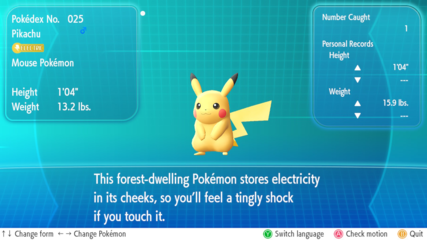
|
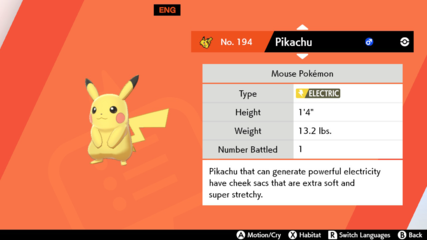
|
|---|---|
| LGPE | SwSh |

|
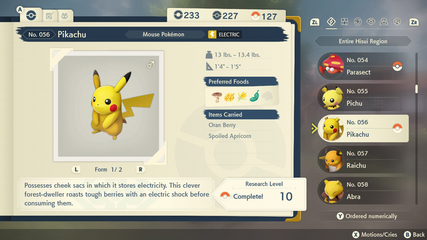
|
| BDSP | LA |
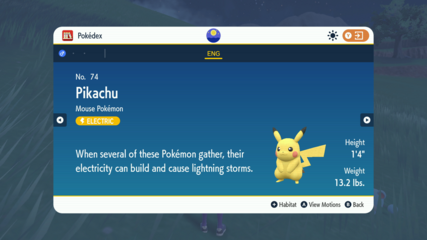
| |
| SV |
Printing entries
- Main article: Game Boy Printer → Pokédex stickers
In Pokémon Yellow, Gold, Silver, and Crystal, it is possible to print entries of caught Pokémon using the Game Boy Printer.
In the Nintendo 3DS Virtual Console version of those games, the Game Boy Printer features still appear in-game but are not functional.
In the side series games
Pokémon Stadium series
- Main article: Pokédex (Stadium)
The Pokédex is available in all games of the Pokémon Stadium series.
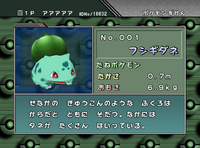
|

|

|
|---|---|---|
| Stadium (Japanese) | Stadium (English) | Stadium 2 |
Pokémon Bank
In Pokémon Bank, as part of its version 1.3 update to be compatible with Generation VII, a National Pokédex feature was also added to Pokémon Bank. Bank's National Pokédex is able to display Pokédex entries from any Generation VI game as well as Pokémon Sun and Moon. The Pokédex is updated based on the data of any game that is used to connect to Pokémon Bank.
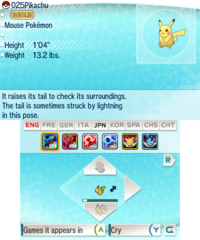
|
|---|
| Pokémon Bank |
Pokémon HOME
- Main article: Pokédex (HOME)
Pokémon HOME a Pokédex feature with entries for all Pokémon from the National Pokédex.

|
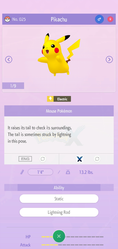
|
|---|---|
| Pokédex entry (home console) | Pokédex entry (mobile) |
In the spin-off games
Pokémon Pinball series
- Main article: Pokédex (Pinball)
The Pokédex (also named "Poké Dex") is available from the main menu and displays a list of caught and seen Pokémon in the games Pokémon Pinball and Pokémon Pinball: Ruby & Sapphire.

|
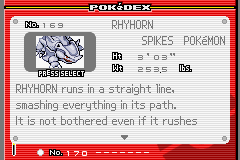
|
|---|---|
| Pokédex (Pokémon Pinball) |
Pokédex (Pokémon Pinball: Ruby & Sapphire) |
Pokémon Trading Card Game series
- Main article: Card (TCG GB) → Pokédex screen
In Pokémon Trading Card Game and Pokémon Trading Card Game 2: The Invasion of Team GR!, the "Check" option is used on any Pokémon card, the player can see some Pokédex-related information about that Pokémon (which is also available in the real-world TCG cards). This includes the Pokédex entry description, the Pokémon's category, height (known as "length"), weight, and National Pokédex number.

|

|
|---|---|
| Squirtle card (Pokédex screen) |
Gengar card (Pokédex screen) |
In the TCG
The Pokémon cards feature a Pokédex text entry, as seen in the games. The Pokédex entries are usually copied from a core series game, although there are exceptions. They also include the Pokémon's category, height (originally printed as "length" in the English translation by Wizards of the Coast), weight, and National Pokédex number.
Trivia
- In HeartGold and SoulSilver, the Pokégear's map displays the hat of Ethan's icon in its updated Generation IV design; however, the Pokédex map displays the icon's hat in its Generation II design.
See also
In other languages
References

|
This item article is part of Project ItemDex, a Bulbapedia project that aims to write comprehensive articles on all items. |
